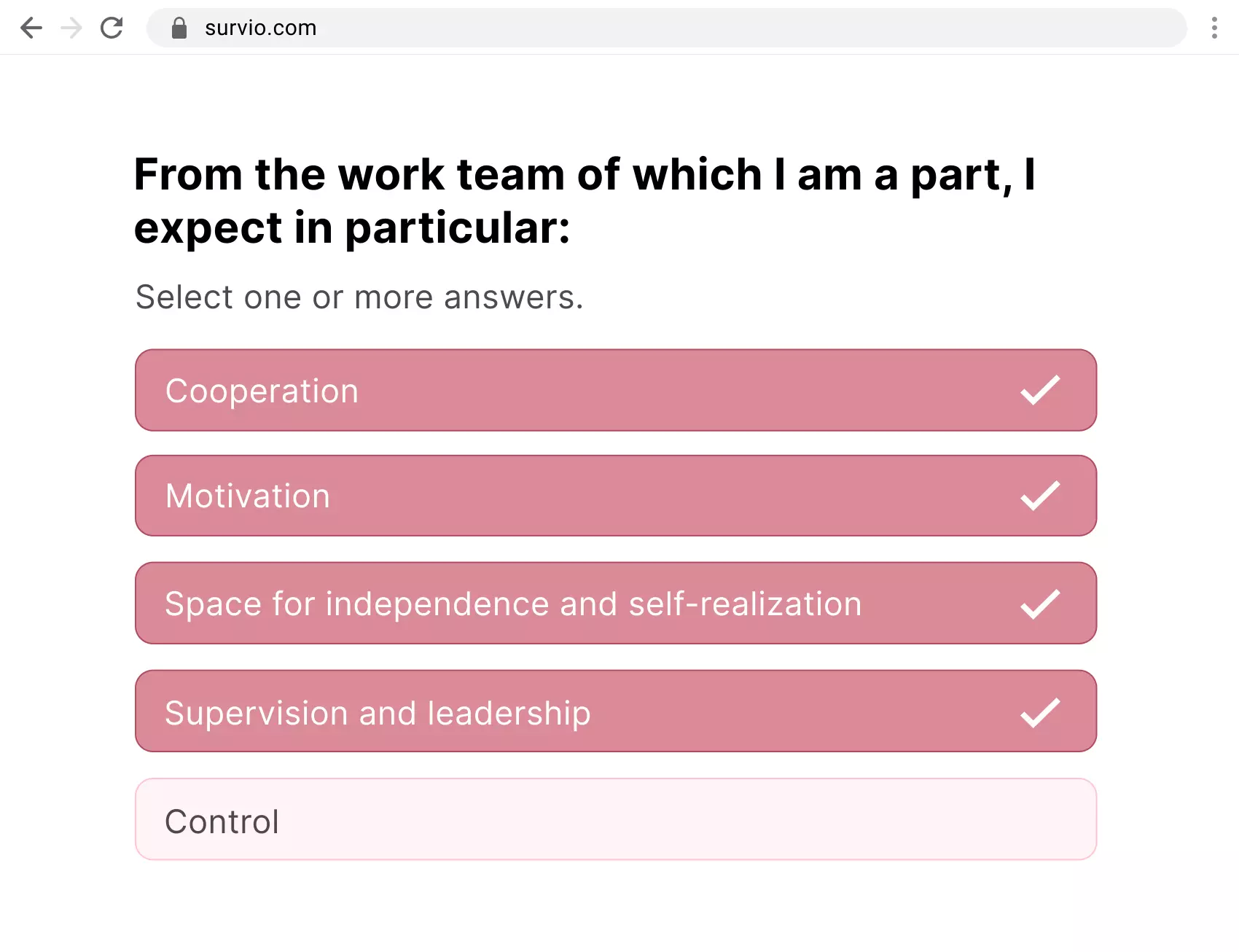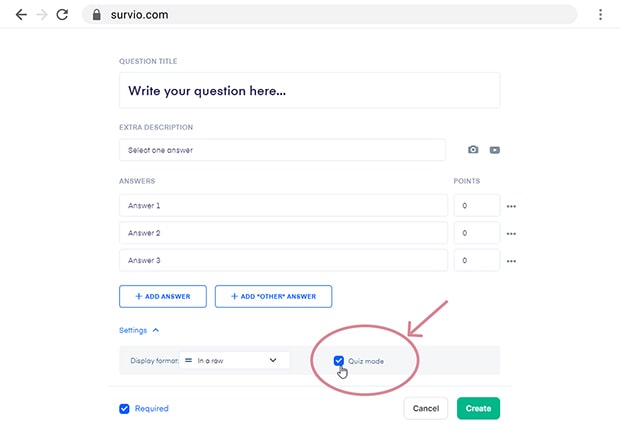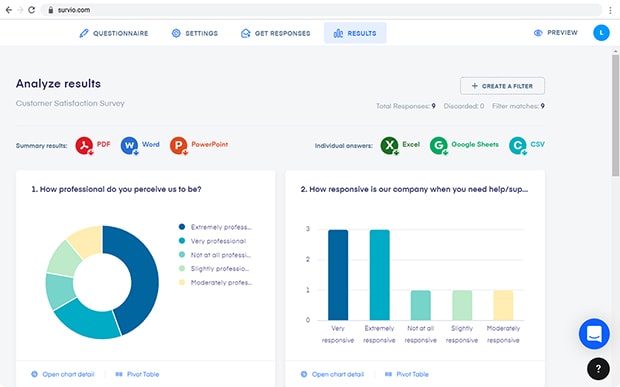- Facilitation and cost-effectiveness of the hiring process
- Comparisons of uniform criteria
- Pre-selection of suitable job candidates
- Gathering relevant information for smooth interaction during personal interviews
Are you looking for suitable candidates to fill positions in your company? Don't just rely on resumes. Use a job seekers survey to ask what you are really interested in. Discover employee potential yet before personal interviews, avoid redundant recruitment activities and make the hiring process more efficient.
Make surveying of potential job candidates a part of your workflow. Integrate the data in your system and access it whenever a new vacancy is about to be filled. Use the surveys repeatedly, customize them to your needs. Take advantage of the opportunity to compile job seekers’ profiles in an effortless way.
Benefits you will get include
- facilitation and cost-effectiveness of the hiring process,
- time efficiency enabling focus on other HR activities than reviewing CV’s,
- comparisons of uniform criteria,
- pre-selection of suitable job candidates,
- gathering relevant information for smooth interaction during personal interviews,
- ability to create questionnaires without any previous experience with recruitment surveys.
Learn from our customer experiences how you and your organization can benefit from using Survio.
Read the case studies
Question types and formulations - ask right to get clear answers
With clearly formulated and comprehensible questions, your respondents will get an exact idea of what you want from them. It will be easier to fill in your recruitment questionnaire and the data they provide will be of much higher quality. At the same time, your questionnaires will achieve a rise in the response rate.
Try to maintain a clear structure of each recruitment questionnaire. When questions naturally follow each other, the respondents hardly get lost incoherently jumping from one topic to another. We recommend considering this layout to keep respondents still in the loop:
- Questions regarding the job candidate (name, level of education, other professional experience and skills, language skills, years of experience, references).
- Questions regarding the offered position (understanding of the scope of work, connection of the position to other departments of the company, expected financial evaluation).
Tip: This part of the recruitment questionnaire can be taken as a quiz. It will help you confirm the knowledge and expertise of candidates presented in their professional resumes. The questions can also be worded as a description of a specific situation for which the applicant is to propose a solution.
- Questions regarding values (personal and work values, workplace equipment, work-leisure ratio, personal strengths and weaknesses).
- Questions regarding motivation (job expectations, employee potential, opportunities for professional growth and self-development).
- Organizational questions (how did the candidate find out about the advertised position, date of possible start, preferred form of contact).
When finding out the factual data that should bring you objective facts and the possibility of straightforward comparison between individual job candidates, use closed-ended questions.
It is also advisable to include open-ended questions in the questionnaire. By means of a text answer, you encourage the job candidates to express their subjective view of a given issue (e.g. expectations regarding the employer, the ability to organize time during working hours, their own contribution to the position, etc.).
Although open-ended questions are more complex to evaluate and do not provide the possibility of automation, they can help you discover a number of topics that a candidate could not point out from the list of answers that you suggest in the closed-ended questions.
To make your surveys more engaging and interactive, you can choose from a selection of 19 question types that Survio offers at your disposal. Asking the right way will encourage respondents to provide accurate answers that reflect reality and therefore deliver relevant data to make your decisions upon.
Practical examples of how to properly use specific types of questions in a survey are available on our blog. For more information on questionnaire structure, pagination and settings, see the article on How to create a survey.
Problematic questions
With regard to the Labor Code and changing cultural norms, it is not appropriate to ask questions related to areas of life such as:
- family background (Do you plan to have children? If so, when?),
- health condition (Are you a smoker? How many cigarettes do you smoke on average per day?),
- church affiliation (What religious denomination do you belong to?),
- political preferences (Which party or movement are you going to support in the next election?).
While some of these facts may be of great interest to you, and their influence on the subsequent decision as to whether or not a job candidate will fit into a team may be indisputable, it is better to follow established cultural rules and applicable laws. Try to find out as much as you can about the job candidates during a personal interview, by using tactful and non-aggressive questions about their personal interests and leisure activities.
Tip: By changing the question settings to a “quiz” mode, it is possible to easily turn your survey into a knowledge test. Each correct answer is assigned with a point, wrong answers get zero. Achieved score, which is calculated automatically in Survio, shows you if the candidate’s awareness of your domain is sufficient to invite them for the personal interview.
Response collection and evaluation is real-time and automated
Imagine a situation that you are filling a vacancy in your company and plan to address internal personnel first. After then, you will address the public to maximize the chances of finding the most suitable candidates to invite for a personal interview. There are a number of distribution channels to share your surveys and collect responses. Use one channel, combine just a few or all of them at once to target as wide a range of applicants as possible.
Embed the survey into your website
Survio allows you to display questionnaires directly on a particular web page. The form is threefold and it is a matter of your choice and preference, which of them best suits the given purpose.
- iframe, ie. making the questionnaire an integral part of the site,
- pop-up window that appears a moment after an employee logs in the attendance portal to assign shift and fill in working hours,
- pop-over widget showing the questionnaire in a gentle tab, attached to the right hand side of a screen after it is clicked on.
An important note worth mentioning at this point is that using any of the previous three options, your survey needs to contain a question asking for the respondent’s e-mail address, otherwise you won’t be able to identify the sender. Iframe as well as pop-up window and pop-over widget collect responses anonymously by default.
Use a QR code
Do you employ workers who don’t sit in the office but make their living in a warehouse, assembly shop or on a construction site? Print out a QR code which contains a link to the questionnaire and display it in a canteen, inside a portakabin or any other visible location. All Survio questionnaires are mobile-friendly, so the workers can simply scan the QR code with their cell phones and answer your questions this way.
Provide a direct link to the survey
Assuming that you already have a list of potential candidates, copy a link from Survio that opens the questionnaire with additional questions asking about visions, personal values, achievements, etc. and paste it to the e-mail you are about to send out. Using your own e-mail agent is perfectly fine but there’s one more option that makes the distribution easier and super comfy.
Create survey e-mail invitations directly in Survio
On condition that you have the contact data to the applicants, add their e-mails in Survio, formulate a common introductory text and let Survio be the “mailman”.
Tip: As a subscriber to one of Survio’s Premium plans, you don’t need to check your mailbox every once in a while to see if there is a new reply. Simply switch on notifications by e-mail and Survio will keep watch to make sure that you don’t miss anything.
We in Survio definitely value your time, which is why all respondents’ answers are analyzed automatically and in real time into aggregate results and individual responses. You can filter the obtained data by answers, by date, by source, by completion time and other parameters. Generated reports can be exported with a single click into the most common formats (PDF, .docx, .pptx, .xlsx, .csv or Google Sheets). Editable formats are open for additional editing so that the documents meet the goal of the presentation you are preparing for.
Interpretation of results, or what do I know about the candidate
At the beginning, you set the evaluation criteria that the job candidate shall meet. You create a set of questions accordingly and share the survey through the most convenient distribution channels. As Survio continuously evaluates the answered surveys and it is up to you to make a qualified decision with the help of this output, which of the job candidates will be shortlisted for a personal interview.
For job seekers questionnaires, you can use the comparison “the candidate meets – does not meet the prerequisites” in the initial phase of the selection. Simply export a table from Survio with an overview of responses related to the candidate’s professional experience. Filter out candidates whose experience meet your requirements and approach them with an invitation to the next round. Send thanks for participating in the hiring process to those who failed.
It is also worth considering a more detailed breakdown of requirements into necessary, desirable, welcome and marginal. In addition to questions comparing professional experience, professional knowledge and practical skills, you can also include questions in the form of model situations in the recruitment questionnaire, where job candidates show a sense of analytical thinking, propose a solution or options of implementation.
Personal interviews offer job candidates the opportunity to specify details to the proposed solutions. It will give you a space to ask additional questions to complete their professional profiles.
Let’s sum up so you can create your own job seekers surveys
Search and recruitment can take place among existing employees (internal resources) or on the labor market (external resources). In both cases, the recruitment questionnaire makes it possible to ascertain the interest in the given position, as well as the initial prerequisites and professional competence of the candidates to hold the vacant position. Whether you decide to target your colleagues or reach the public via expansive job candidate search, here are some helpful tips on how to approach the recruitment questionnaire creation:
- Try to make the questionnaire easy to understand. Let the candidates know that your company is built on natural interpersonal communication and team spirit. This will provide you with more honest, open and truthful responses.
- Where it is not absolutely necessary, avoid complicated corporate jargon in the questionnaire.
- Choose an easily accessible form for sharing a survey. Job seekers surveys created in Survio work great with all standard types of devices – desktops, tablets, smartphones.
- Tell the respondents at the beginning how long it will take them to complete the recruitment questionnaire. By doing so, you will show respect for the time they devote to you and it will certainly strengthen your credibility as a potential employer.
Remember that the survey process does not end with the recruitment of the employee. Quite the opposite. Onboarding of new employees is usually costly. Therefore, to have happy and loyal employees who will help your company achieve great results, profitability, productivity and overall success, you need to keep asking. Survio comes up with dozens of ready-made, but fully editable survey templates.
Save your company the expenses associated with the recruitment of new employees and time you can devote to other activities related to human resources. Use our survey templates focused on various topics and let your HR management rely on Survio.







